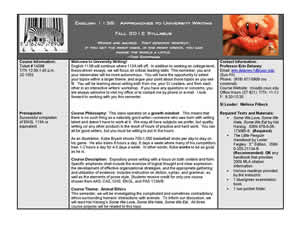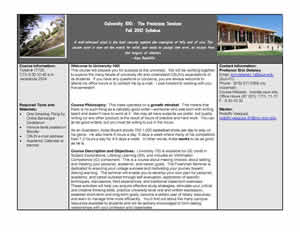The Visual Syllabus: New Ways to Communicate Course Content

Program details:
Back in the day, the syllabus was a study in black and white. Typewriters ruled. Words rocked.
Words still rock. But now your syllabus is likely to exist both as a classroom handout and as a web-based document. You have new opportunities to communicate and organize course content and requirements by using a splash of color, a series of images, and other mainstays of the visual vocabulary.
CSUN faculty member Erin Delaney (English and Academic First Year Experiences) provided an overview of the possibilities and engaged participants in a critique of several sample syllabi. You'll find her workshop resources listed below along with additional helpful materials.
Tips from the Workshop
As part of the workshop, Erin and the participants suggested some starting points:
- Take advantage of relevant graphic elements like the CSUN wordmark or the logos for Moodle and TurnItIn.
- Put a so-called "hero picture" (a relatively large one) at the top of your first page to generate discussion and to offer students an interpretive point of entry into the subject matter of your course.
- Repeat syllabus images on related later handouts to provide organizational help to your students.
- Looking for images that you can use without violating copyright law? Try openclipart.org and Wikimedia Commons.
- Consider distributing an abridged syllabus in class and providing full details online.
- Leave room on your paper syllabus so students can annotate, mark, or highlight information that they consider important. Include checkboxes to help students track their progress.
Resources
- Accessibility at CSUN: start with the how-to document for Word 2007. A terrific tool is the (free) WAVE toolbar which you can add to Firefox to check basic accessibility.
- Delaney, Erin. Session handouts included a brochure (pdf, 428 KB) and a slideshow (pptx, 3.2 MB). January 2013. The sample syllabi she provided as part of the workshop included several from the web as well as an old-school syllabus Erin used a few years ago.
- Jones, Jason B. "Creative Approaches to the Syllabus." Prohacker. Blog. 26 Apr. 2011.
- Little, Deandra, and Felten, Peter. "When Images Rule." Micro-articles published in the NEA Advocate as part of the series "Thriving in Academe." April 2010. Online.
- Moodle basics: log in to Moodle (http://moodle.csun.edu/) from the CSUN main page; choose CSUN Moodle Community (http://moodle.csun.edu/course/view.php?id=7, for faculty and staff only); and in Topic 5, start with Moodle Basics and Moodle Activities.
- Technology training (their word, not mine) at CSUN: http://www.csun.edu/it/training (includes videos, live classes, step by step documents, and more)
- Policy on Written Syllabi for All Graduate Courses: CSUN policy. (Approved 2/2/06.)
- Written Syllabi for All Undergraduate Courses: CSUN policy. (Approved 5/8/01; modified 3/25/03.)
- Need to talk to somebody about Moodle or technology? That would be the folks at the Faculty Technology Center: 818-677-3443.

About "Thriving in Academe: The View from CSUN"
"Thriving in Academe" is the name of a short feature (usually four pages) published in each issue of the NEA Higher Education Advocate. Each topic featured in "Thriving in Academe" is treated in about five "micro-articles"; all are available on the Web. "Thriving in Academe," as the Advocate website explains, exists "to promote . . . effective teaching and learning in higher education through dialogue among colleagues" by featuring short, informal essays on best practices. Each session listed here offers links to an "Overview" and the "Table of Contents" leading to the micro-articles on that topic.
In each session of our CSUN series, participants will join a faciliated discussion on that day's topic with a local focus on "The View from CSUN." Read the relevant micro-articles from that issue of "Thriving in Academe" and be ready to converse with your colleagues.
